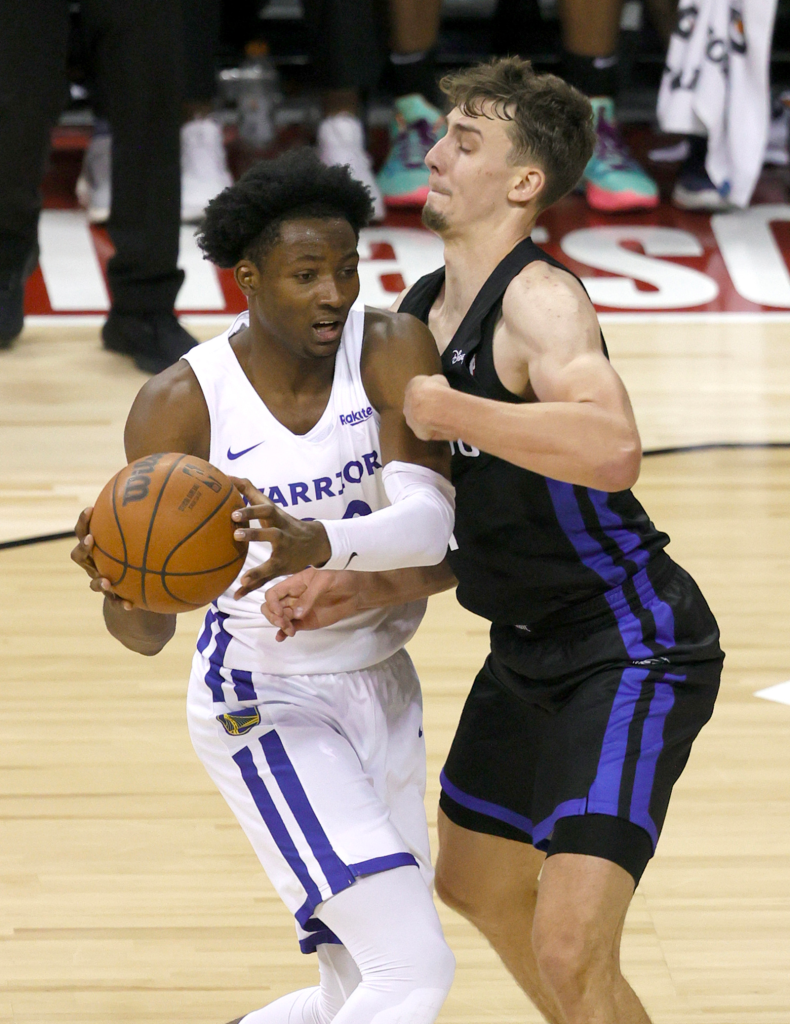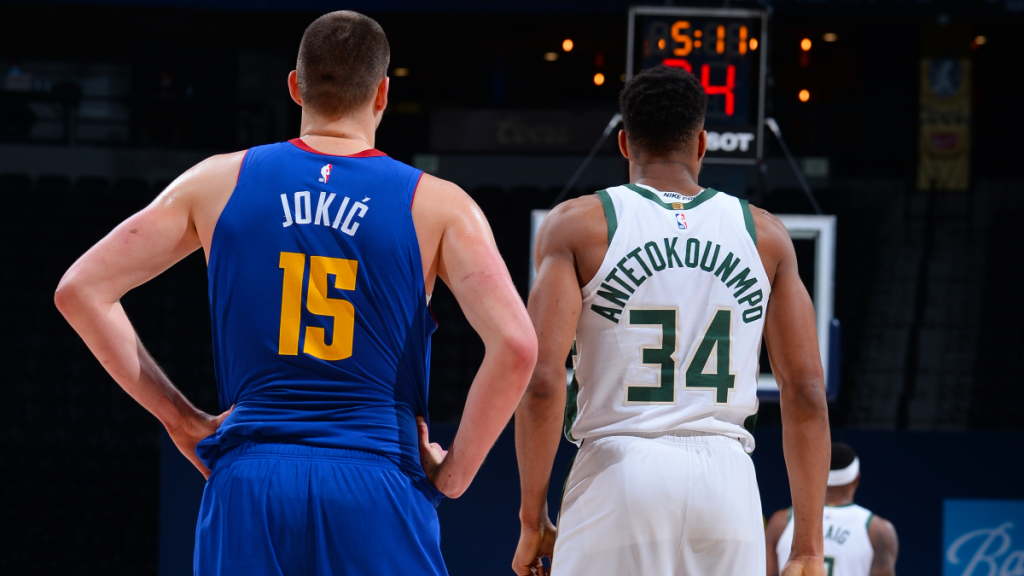
Traditional NBA draft wisdom dictates that teams should place a large emphasis on prospect upside. Championship runs are typically driven by star players, and stars are rarely available in trade or free agency. The draft is the best place to gamble on star upside, so why not roll the dice and hope to get lucky on a high risk, high reward prospect over a presumed solid rotation player?
Kuminga over Franz
The best recent example of this logic failing was in 2021 when the Warriors drafted Jonathan Kuminga 7th overall over Franz Wagner. Kuminga had perceived higher upside due to his elite frame and athleticism which Franz sorely lacked. But Kuminga was coming off a mediocre season for G-League ignite, whereas Franz was elite for Michigan.
And not only was Franz elite, but he was elite in every aspect necessary for NBA success. He was the only non-top 4 prospect that I have ever perceived as unbustable. His only real concerns were he did not rack up points and rebounds at Michigan like you would expect from a traditional star wing, which seemingly limited his upside. My favorite NBA comparison for him was Otto Porter Jr.
Conversely, Kuminga had flags on flags on flags. His handle and shooting were subpar. His defensive IQ was questionable. He had questions regarding his work ethic and the company he kept. And while he was listed as one of the youngest players in the draft, there were questions about whether he was actually his listed age.
There were loads of questions marks that needed to go his way to succeed. It is like he needed 5 or 6 different coinflips to fulfill his upside, which is not great odds for a mid-lottery pick (1.5-3%).
And even then that still may only amount to a fringe all-star like Jaylen Brown. To be a top 5 MVP candidate perhaps he needed 9 or 10 successful coinflips to fulfill that upside (0.1-0.2%). It’s impossible to estimate the exact percentage odds, but this should be a basic framework for visualizing upside tails. The more question marks a player has, the more coinflips need to be parlayed for his upside to be hit.
For the sake of argument, let’s there are 9 high leverage coinflips that determine Kuminga’s outcome. 9 successful flips yield 1st team all NBA (0.2%), 8 yield Jaylen Brown (1.8%), 7 yield an average starter (7%), 6 yields an average rotation player (16%), and 5 yields fringe rotation (25%), and 4 or less is a replacement player or bust (50%).
What is particularly frustrating how much more likely middle ground outcomes which teases enough hope of potential getting fulfilled are (48%) than actually being an all-star (2%). Granted these percentages are conjecture and conceivably could be harsh– but the idea is that by parlaying too many things that need to go right for upside to hit, you are left with a poor range of outcomes.
NBA Teams Err on Side of Sunk Cost Fallacy
Andrew Wiggins disappointed in his first few NBA seasons for a #1 overall pick, but not enough to stop the Timberwolves from extending him for 5 years @ $146.5 million. Then when he continued to disappoint, they paid a 1st round pick (that was coincidentally used on Kuminga) to swap him for D’Angelo Russell. His redemption arc in Golden State ultimately made this extension not bad value for his new team, but he nevertheless signed his next extension for a more economical 4/109 in spite of a significant cap increase coming.
Phoenix recently re-signed DeAndre Ayton for 4/133, only to watch their talented but enigmatic player regress in the first season of his new deal. Atlanta traded picks #8, 17, and 35 to move up in the draft for DeAndre Hunter, and then committed 4/90 to essentially a 25 y/o replacement level player. Zion Williamson got 5/193 after playing a total of 85 games in his first 3 seasons.
NBA teams regularly fall victim to sunk cost fallacy. They will continue to invest in the upside of their prospects so long as they don’t completely bust. This makes it dangerous to gamble on upside players who need too many things to go right to fulfill their upside.
Right now Kuminga is in this zone of mediocrity where he has shown enough potential to maintain intrigue, but he may never actually be a useful NBA player. It would not be a surprise if he gets overpaid in his first major contract, and then fails to live up to the value.
But what about Giannis?

Once in a while a mystery box prospect will grow two inches, fill out from a skinny kid into an explosive tank, and make major leaps in his game every season and become Giannis. But it may be another 100+ drafts before we see another young + toolsy mystery box succeed like him. Much more commonly you end up with either a bust, or a somewhat useful but flawed player who the team continues to over-invest in.
And as great as it is to hit on a Giannis in the mid-1st, it is even better to land a Nikola Jokic in the mid-2nd. Jokic required a much less valuable pick, and based on pre-draft info he clearly had a better median outcome than Giannis.
Jokic slid a full round later than Giannis due to his perceived lack of upside in spite of having excellent performance as a teenager in the Adriatic League, while Giannis struggled in his small samples of lower Greek Divisions. Yet they have had similarly valuable NBA careers.
Given the superior cost efficiency of Jokic and that no mystery box has provided close to the value of Giannis, it is difficult to argue that pure upside swings actually offer more upside than perceived low upside players who are clearly good.
The Best Predictor of Upside is Floor
Looking back at Franz Wagner, there were such few questions marks about his game. He had been shooting 80%+ from the line since he was 15 years old. He had elite wing dimensions, excellent lateral mobility, and his defense was fundamentally near perfect. He could handle and pass and had a pristine basketball IQ. The only real question was how much offense could he create in the NBA as a 19.2 usage college player who averaged 12.5 points as a sophomore.
The answer turned out to be as good as anybody could have hoped, as he is now a 24.4 usage NBA player averaging 19.9 pts on 59.7% at 21 years old. The odds of this happening based on pre-draft info seemed fairly low, but he did show competent NCAA penetration with excellent coordination to step through defenses. In tandem with his skill level and basketball IQ, he was able to succeed at this in the NBA much better and faster than expected.
Given how awesome he was in all other aspects of the game, perhaps this should not be such a large surprise. Regardless, it is just one thing that went unexpectedly right and suddenly he is looking like a future star.
Consider all of the aforementioned points that needed to go right for a prospect like Kuminga to even become a Jaylen Brown type. After *one* point that went right for Franz, he is now rated higher than Jaylen in metrics such as EPM (+3.6 vs 2.8) and RAPTOR (+3.2 vs +0.2). Also Haralabos Voulgaris has mentioned the model he used to make millions betting on the NBA rated Franz 15th in the league.
There are other metrics that rate Brown higher, so it is not crystal clear that Franz is the better player at this time. But he is 5 years younger at age 21 vs 26, and it is only a matter of time before Franz becomes the clearly superior player.
This is the magic of having a high floor. A quality role player may only need one or two things to go right to become a star. And it is more comfortable to pay to extend a young player who is already valuable. If Franz “only” peaked as a pre-injury version of Otto Porter Jr, that would still be a great return on a mid-lottery pick. Even if he disappointed and hit my floor comp of Mikal Bridges, you’re still getting a solid guy. Nobody objected to Phoenix extending Mikal for 4/90.
Why is Floor so Commonly Underrated?
The main issue is that draft consensus is bad at estimating floor. Older prospects who simply aren’t good enough for the NBA often get the “high floor” label. Then when they bust, it makes the label seem meaningless. If high floor and high ceiling players both are capable of busting, why not just swing for the upside fences?
In reality, high floor should mean high confidence that a prospect will be a useful NBA player. And high confidence that a prospect will be a useful NBA player strongly correlates with that player having a high upside. Younger prospects will typically have higher error bars in both directions.
It’s not always a perfect correlation. There are players who have higher error bars due to being obviously talented but swing heavily based on murky shooting and defense outcomes. Scottie Barnes and Alperen Sengun are two examples of this from 2021. But they still had high floors in their own rites– Sengun has been disappointing at both shooting and defense and still appears to be a steal at 16th overall.
Bottom Line
Draft concepts such as floor and ceiling are often applied inaccurately and lead to inefficient decision making. But if one of them should be given more weight when accurately measured– it is floor.
It is difficult to trump a high confidence that a prospect will be a valuable NBA player. That way you maximize outcomes where you get positive value out of a pick, and minimize outcomes where you end up committing longterm money and a significant role on the team on a player who never provides close to the desired outcome.
And most importantly, confidence in a prospect’s ability to be valuable in the NBA is one of the best predictors of upside as well.
It can be fun to imagine “what if everything goes perfectly in this prospect’s development,” but outside of Giannis this essentially never happens. Flaws from a young age often persist through a player’s prime, at least to some non-trivial extent. It is far more efficient to focus on the likely outcomes.
Upside deserves some consideration, but not as much as it commonly receives. Much like construction of a building, the foundation of efficient draft analysis starts at the floor.



